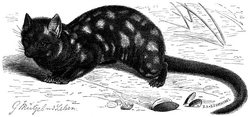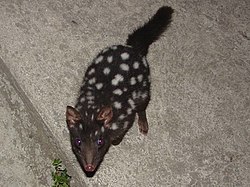Difference between revisions of "AY Honors/Marsupials/Answer Key"
m (Transwiki:Quoll moved to AY Honor Marsupials: transwiki merge) |
m (61 revisions from w:Eastern Quoll) |
||
| Line 1: | Line 1: | ||
| − | {{Taxobox | + | {{Taxobox |
| − | | name = | + | | image = Dasyurus_viverrinus.jpg |
| − | | | + | | image_caption = Eastern Quoll |
| − | | | + | | name = Eastern Quoll<ref name = MSW3>{{MSW3 Groves|pages=25}}</ref> |
| − | | regnum = [[ | + | | status = LR/nt |
| − | | phylum = [[ | + | | status_system = iucn2.3 |
| − | | classis = [[ | + | | trend = down |
| − | + | | status_ref = <ref>{{IUCN2006|assessors=Australasian Marsupial & Monotreme Specialist Group|year=1996|id=6296|title=Dasyurus viverrinus|downloaded=11 May 2006}}</ref> | |
| + | | regnum = [[Animalia]] | ||
| + | | phylum = [[Chordata]] | ||
| + | | classis = [[Mammalia]] | ||
| ordo = [[Dasyuromorphia]] | | ordo = [[Dasyuromorphia]] | ||
| familia = [[Dasyuridae]] | | familia = [[Dasyuridae]] | ||
| − | | | + | | genus = ''[[Dasyurus]]'' |
| − | + | | species = '''''D. viverrinus''''' | |
| − | | | + | | binomial = ''Dasyurus viverrinus'' |
| − | | | + | | binomial_authority = ([[George Shaw|Shaw]], 1800) |
| − | + | | range_map = Dasyurus viverrinus distribution map.PNG | |
| − | | | + | | range_map_caption = Distribution of Eastern Quoll |
| − | | | ||
| − | | | ||
| − | |||
}} | }} | ||
| − | ''' | + | The '''Eastern Quoll''' (''Dasyurus viverrinus''), also known as the '''Eastern Native Cat''', is a medium-sized [[carnivorous]] [[dasyurid]] [[marsupial]] native to [[Australia]]. They are now considered extinct on the mainland, but remain widespread and even locally common in [[Tasmania]]. It is one of six extant species of [[quoll]]. |
| − | The | + | == Taxonomy == |
| + | The Eastern Quoll is a member of the family [[Dasyuridae]], which includes most carnivorous [[marsupial]]s. Its species name, ''viverrinus'', indicatest that it is "ferret-like".<ref name=Strahan>{{Citation|last1=Godsell|first=J.|contribution=Eastern Quoll|title=The Mammals of Australia|year=1995|publisher=Reed Books|pages=70-71|editor-first=Ronald|editor-last=Strahan}}</ref> The species was first described in 1800 by [[George Shaw]], who placed it in the [[opossum]] genus ''[[Didelphis]]'', along with the only other then-known [[quoll]], the [[Tiger Quoll]]. | ||
| − | == | + | == Description == |
| − | + | [[Image:Tüpfelbeutelmarder brehm.png|thumb|left|220px|Illustration of an Eastern Quoll by [[Brehms Tierleben]].]] | |
| − | + | The Eastern Quoll is generally about the size of a small [[domestic cat]], with an adult male averaging 60cm and weighing approximately 1.3kg. Their thick coat is covered by white spots, and ranges in colour from a light fawn to a near black, with an off-white belly. They can be distinguished from the [[Tiger Quoll]] by their slender build, pointed snout and lack of spots on the tail. | |
| − | + | ||
| − | + | == Behaviour == | |
| − | + | The Eastern Quoll is a solitary predator, hunting at night for its prey of insects and small mammals. They have also been known to scavenge food from the much larger [[Tasmanian Devil]]. | |
| − | + | ||
| − | + | The breeding season begins in early winter, and the female gives birth to up to 30 young. Of these, the first to attach themselves to the six teats will be the only survivors. Weaning takes place at about 10 weeks of age, with the young staying in the den whilst the mother forages. | |
| − | + | == Threats == | |
| + | [[Image:Eastern Quoll (Black).JPG|thumb|right|220px|A black eastern quoll photographed in Tasmania.]] | ||
| + | The main threats to the Eastern Quoll are competition and predation from feral cats and illegal poisoning and trapping. The lack of [[fox]]es and [[dingo]]es in Tasmania is believed to have contributed to the survival of the species. | ||
| − | The | + | == Mainland extinction == |
| + | The last mainland Eastern Quoll specimen was collected as roadkill in [[Sydney]]'s Nielsen Park, [[Vaucluse]] on 31 January 1963.<ref name="AMDB">{{cite web|url=http://www.amonline.net.au/mammals/collections/sydney/record.cfm?id=281 | ||
| + | |title=Sydney mammals database, Eastern Quoll|author=Australian Museum|publisher=Australian Museum|date=2003|accessdaymonth=12 February |accessyear=2007}}</ref> The National Parks and Wildlife service reports numerous unconfirmed sightings up until 1999 (the year of the report),<ref name="NPWS">{{cite web|url=http://www.nationalparks.nsw.gov.au/PDFs/tsprofile_eastern_quoll.pdf | ||
| + | |title=Threatened Species Information, Eastern Quoll|author=National Parks and Wildlife Service|publisher=National Parks and Wildlife Service|date=1999|accessdaymonth=12 February |accessyear=2007}}</ref> and the species was reported sighted as recently as 2006.<ref name="Hawkesbury">{{cite web|url=http://www.hawkesbury.yourguide.com.au/detail.asp?class=lifestyle%20news&subclass=habitat&story_id=527302&category=environment | ||
| + | |title="Extinct" marsupial may be alive and well - NSW|author=Rebecca Lang|publisher=Hawkesbury News|date=2006-11-01|accessdaymonth=12 February |accessyear=2007}}</ref> | ||
| − | ==References== | + | == References == |
{{reflist}} | {{reflist}} | ||
| + | |||
| + | == External links == | ||
| + | *[http://warrawong.com/meet_the_animals.html Eastern Quolls at Warrawong Sanctuary, the largest captive breeding program in mainland Australia.] | ||
| + | *[http://www.nationalparks.nsw.gov.au/PDFs/tsprofile_eastern_quoll.pdf National Parks and Wildlife Service Threatened Species Information - Eastern Quoll.] | ||
{{Dasyuromorphia|D.D.}} | {{Dasyuromorphia|D.D.}} | ||
| − | |||
| − | |||
[[Category:Dasyuromorphs]] | [[Category:Dasyuromorphs]] | ||
| − | [[Category: | + | [[Category:Mammals of Tasmania]] |
| + | [[Category:Extinct mammals of South Australia]] | ||
| + | [[Category:Mammals of New South Wales]] | ||
| + | [[Category:Mammals of Victoria]] | ||
| + | [[Category:Marsupials of Australia]] | ||
| − | [[ | + | [[cs:Kunovec tečkovaný]] |
| − | [[de: | + | [[de:Tüpfelbeutelmarder]] |
| − | [[es:Dasyurus]] | + | [[es:Dasyurus viverrinus]] |
| − | [[fr: | + | [[fr:Chat marsupial moucheté]] |
| − | [[ | + | [[hu:Foltos erszényesnyest]] |
| − | [[la:Dasyurus]] | + | [[la:Dasyurus viverrinus]] |
| − | [[ | + | [[lt:Viverinė sterbliakiaunė]] |
| − | [[ | + | [[nl:Gevlekte buidelmarter]] |
| − | [[ | + | [[pl:Niełaz plamisty]] |
| − | + | [[zh:東袋鼬]] | |
| − | |||
| − | |||
| − | [[zh: | ||
Revision as of 03:37, 24 July 2008
Template:Taxobox The Eastern Quoll (Dasyurus viverrinus), also known as the Eastern Native Cat, is a medium-sized carnivorous dasyurid marsupial native to Australia. They are now considered extinct on the mainland, but remain widespread and even locally common in Tasmania. It is one of six extant species of quoll.
Taxonomy
The Eastern Quoll is a member of the family Dasyuridae, which includes most carnivorous marsupials. Its species name, viverrinus, indicatest that it is "ferret-like".& The species was first described in 1800 by George Shaw, who placed it in the opossum genus Didelphis, along with the only other then-known quoll, the Tiger Quoll.
Description

The Eastern Quoll is generally about the size of a small domestic cat, with an adult male averaging 60cm and weighing approximately 1.3kg. Their thick coat is covered by white spots, and ranges in colour from a light fawn to a near black, with an off-white belly. They can be distinguished from the Tiger Quoll by their slender build, pointed snout and lack of spots on the tail.
Behaviour
The Eastern Quoll is a solitary predator, hunting at night for its prey of insects and small mammals. They have also been known to scavenge food from the much larger Tasmanian Devil.
The breeding season begins in early winter, and the female gives birth to up to 30 young. Of these, the first to attach themselves to the six teats will be the only survivors. Weaning takes place at about 10 weeks of age, with the young staying in the den whilst the mother forages.
Threats
The main threats to the Eastern Quoll are competition and predation from feral cats and illegal poisoning and trapping. The lack of foxes and dingoes in Tasmania is believed to have contributed to the survival of the species.
Mainland extinction
The last mainland Eastern Quoll specimen was collected as roadkill in Sydney's Nielsen Park, Vaucluse on 31 January 1963.& The National Parks and Wildlife service reports numerous unconfirmed sightings up until 1999 (the year of the report),& and the species was reported sighted as recently as 2006.&
References
- ↑ Template:Citation
- ↑ Australian Museum (2003). "Sydney mammals database, Eastern Quoll". Australian Museum. http://www.amonline.net.au/mammals/collections/sydney/record.cfm?id=281. Retrieved 2007.
- ↑ National Parks and Wildlife Service (1999). "Threatened Species Information, Eastern Quoll". National Parks and Wildlife Service. http://www.nationalparks.nsw.gov.au/PDFs/tsprofile_eastern_quoll.pdf. Retrieved 2007.
- ↑ Rebecca Lang (2006-11-01). ""Extinct" marsupial may be alive and well - NSW". Hawkesbury News. http://www.hawkesbury.yourguide.com.au/detail.asp?class=lifestyle%20news&subclass=habitat&story_id=527302&category=environment. Retrieved 2007.
External links
- Eastern Quolls at Warrawong Sanctuary, the largest captive breeding program in mainland Australia.
- National Parks and Wildlife Service Threatened Species Information - Eastern Quoll.
cs:Kunovec tečkovaný de:Tüpfelbeutelmarder es:Dasyurus viverrinus fr:Chat marsupial moucheté hu:Foltos erszényesnyest la:Dasyurus viverrinus lt:Viverinė sterbliakiaunė nl:Gevlekte buidelmarter pl:Niełaz plamisty zh:東袋鼬

